MAGNIFICENT QUECHUA INDIAN IKAT PONCHO Ceremonial Vintage Textile TM8255


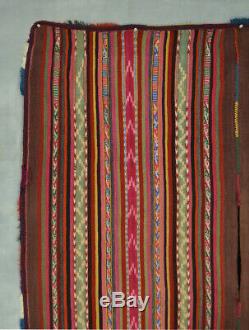
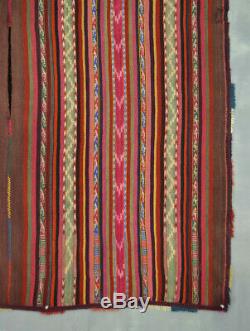
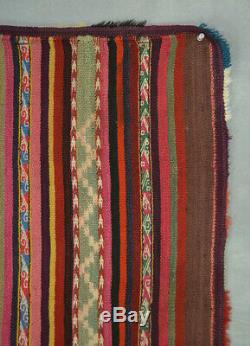
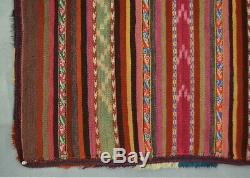


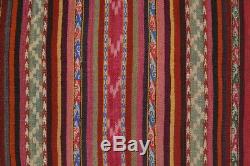

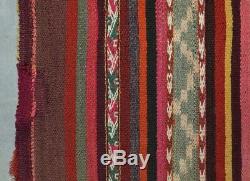
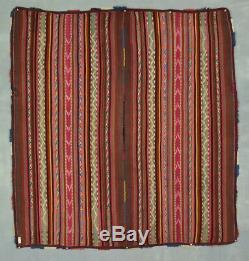


Experts in Finding Rare Ancestral Art for Your Collecting Interests A TERRIFIC VINTAGE INDIAN PONCHO FROM HIGHLAND BOLIVIA. Type of Art: A fine ceremonial indigenous South American Indian poncho. Origin: Field-collected in Molino Village, Canton Chillma, Municipio Caiza, Provincia Nor Chichas, Department of Potosí, Bolivia, South America. Approximate Size: 57.5 inches by 55 inches, including the 1.5-inch fringe. Use: A man s poncho for ceremonial wear. This was a prestigious textile worn by an individual of great social status. There are no holes, stains or worn spots. There is no dye-run (bleeding). There are two spots on the sides of the poncho with excellent, near-professional, native repair measuring 2 inches in length. A detailed condition report is available on request. Remarks: This is a marvelous indigenous Native American hand-woven, warp-faced man's poncho from the Eastern Andean Cordillera in the Bolivian highlands.
It represents the last phase of these rare, ikat textiles. There are six wide bands of warp ikat designs in two different color combinations. The light green colors in four of the ikat bands is woven from llama fibers with a minor mixture of sheep wool. The burgundy brown field color, seen in the lateral bands and the wide center band, is dyed with kitchen soot called q usmi. TM8255 is an impressive and exceptional tribal textile that was very finely and tightly woven with about 62 warps per inch and 12 wefts per inch.
Apart from the ikat bands there are 20 additional bands in complementary warp design. Four bands each include complicated hooked triangles and ancient siyanu patterns, respectively. Siyanu patterns are complex interwoven abstract designs incorporating several different colors with none being dominant. We encourage you to ask for additional information or photos.Our studies and collecting of South American indigenous arts began in 1977. International Bolivian postal service is suspended during the C-19 pandemic. In 12 to 14 days.
AND INCLUDE TRACKING NUMBERS FOR YOUR CONVENIENCE. PREHISTORIC, PRE-COLUMBIAN, ANCIENT = Before around A. 19th CENTURY = 1800 to 1899. TURN-OF-THE-19TH-CENTURY = 1890 to 1910. EARLY-20TH CENTURY = 1900 to 1933.MID-20TH CENTURY = 1934 to 1966. LATE-20TH CENTURY = 1967 to 1999. TURN-OF-THE-20TH-CENTURY = 1995 to 2005. EARLY-21ST CENTURY = 2000 to Present. ANTIQUE = Over 50 years old.
VINTAGE = Over 30 years old. CONTEMPORARY = Made in the last 5 years.
CIRCA = Approximately/around/within a few years of. ANDES AMAZON TEXTILE CONDITION TERMS. Terms used to describe the physical condition of textiles is often subjective and varies greatly from one observer to another. What certain dealers identify as mint condition, we call good; what some call excellent condition, we call fair.
Following are explanations of the terms we use. Unused -- as if recently removed from the loom. No wear or patina of any kind. These textiles may have nubs or even loose, uncut threads left over from the weaving process.
EXCELLENT = Usually only lightly used, often well-guarded or stored for many years. Some textiles might exhibit insignificant, light wear, staining or soiling from use.
Older textiles commonly show, patina and sheen from age. The colors may have muted ever so slightly due to age or exposure, often improving the beauty of a textile. From a displayable distance, textiles appear perfect. VERY GOOD = Usually lightly or only periodically used. The textiles often lightly but evenly worn with no tears or distracting holes.
Older textiles may exhibit lightly darkened surfaces from use and age (staining and soiling) or with lightly noticeable discoloration. At a displayable distance, textiles appear in outstanding condition. GOOD = Usually moderately to well-used. Light to medium staining, either isolated or throughout, represents a common characteristic of this condition. Parts of the textile may feature tiny holes from wear, occasionally exposing hidden warp or weft yarns. Lightly frayed edges often manifest in these textiles.Surface discoloration due to age and exposure often improves the appearance of a textile in GOOD condition. Light or isolated, dye run occasionally appears.
Textiles display well, despite minor damage. FAIR = Either well-used or moderately abused. Bleeding or dye run as well as extensive wear characterize these textiles.
Missing sections of fringe, tassels or edges often result from overuse. Many 20th-century weavings exhibit noticeably faded colors. Textiles in otherwise excellent condition may contain a single isolated sector of damage, such as a large hole, that greatly reduces its aesthetic appeal. Most vintage tribal textiles for sale in the Western Hemisphere constitute those in FAIR to GOOD condition. POOR = Textiles exhibiting extreme usage and damage.
These pieces do not display well and serve primarily as study specimens or examples of very rare textiles. We believe the world deserves improving. We believe in a higher, aspiring destination for humanity. We know that conflicts decline through mutual respect.
We know that understanding our differences leads to mutual wellbeing. We trust that our Mother Earth and our Universe provide unlimited resources for every man, woman and child to live in peace, happiness and love. As stewards of the human race, our intrinsic responsibility rests on improving our world as much as possible.
Native groups, also known as tribal folk, original residents, indigenous people, aboriginals, First Nations, traditional ethnicities, autochthonous societies, autochthonal cultures, et. Dominated human existence until recently. At some point, of course, we all shared common ancestors regardless of current culture, creed or color. Regrettably, however, in the past 500 years or so, thousands of unique tribal groups disappeared due to misunderstanding and impudence.
Uncontrolled aspects of colonialism, ethnocentrism, racism and politicization led to the direct and circuitous destruction of myriad native groups, each representing a valuable resource for our planet. Over 6000 of the nearly 7000 languages currently spoken face danger of extinction. The vast majority of those constitute ethnic indigenous tongues. We believe in cherishing and carefully supporting the very few Native groups that remain on earth, even while standing on the brink of losing them.Disconnecting with indigenous spirit, wisdom and traditional knowledge represents a loss for all of us. In many cases, physical creations represent our only resources for understanding past human beliefs and aspirations. For more than a quarter century, the professional interests of those behind ANDESAMAZON remain dedicated to documenting traditional South American indigenous cultures, especially through their material culture. Our field studies lead us to some of the most remote people on the continent.
Through the years, we witnessed certain Native Americans existing nearly exactly as their ancestors did in prehistoric times and others jumping from 18th century existence to 21st century reality in the blink of an eye. The benefits of our ethnographic investigations manifest as valuable data related to linguistics, cultural history, ethno-environmental relationships, socio-cultural organization, cosmology, mythology, spirituality and of course, material culture. Our holistic approach to understanding the past through material arts contributes authentic information related to the people who created those pieces.
Not only can beautiful and interesting objects enhance ones´ personal environment, but they also provide invaluable knowledge regarding different ideologies, unique ways of life and past or nearly extinct traditions. ANDESAMAZON suggests sharing with companions, friends and especially children, whatever understanding, knowledge and insights you obtain from our objects. In this small way, we feel inspired in preserving something of native cultures and making the world a better place. Thank you for working with us.THANK YOU FOR YOUR INTEREST AND SUPPORT. The item "MAGNIFICENT QUECHUA INDIAN IKAT PONCHO Ceremonial Vintage Textile TM8255" is in sale since Sunday, December 15, 2019. This item is in the category "Antiques\Ethnographic\Native American". The seller is "andesamazon" and is located in Santa Cruz, . This item can be shipped worldwide.


